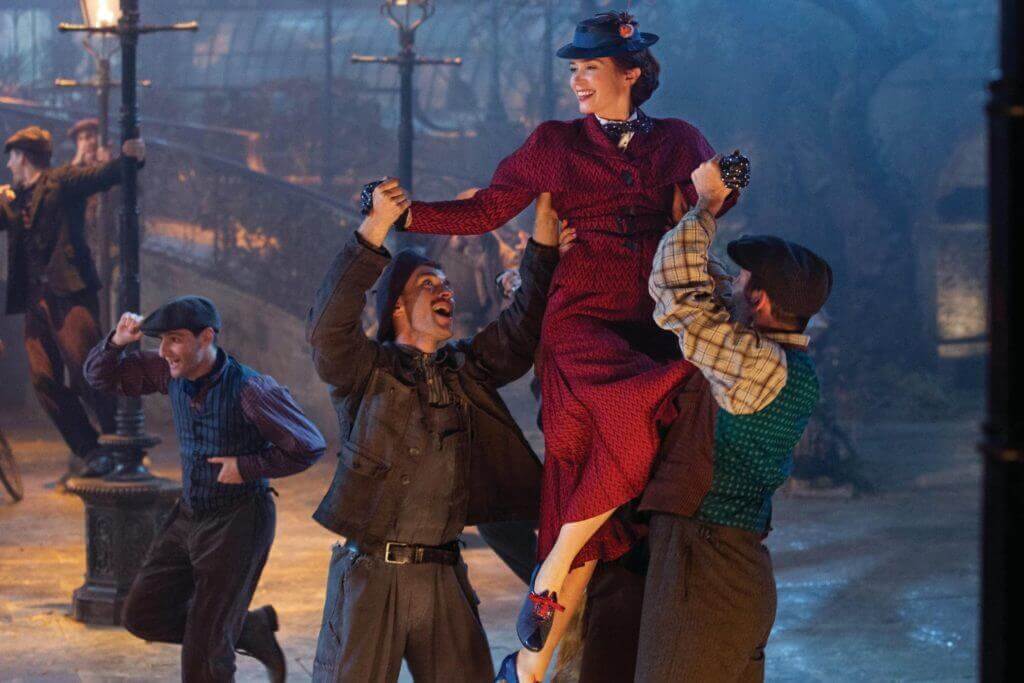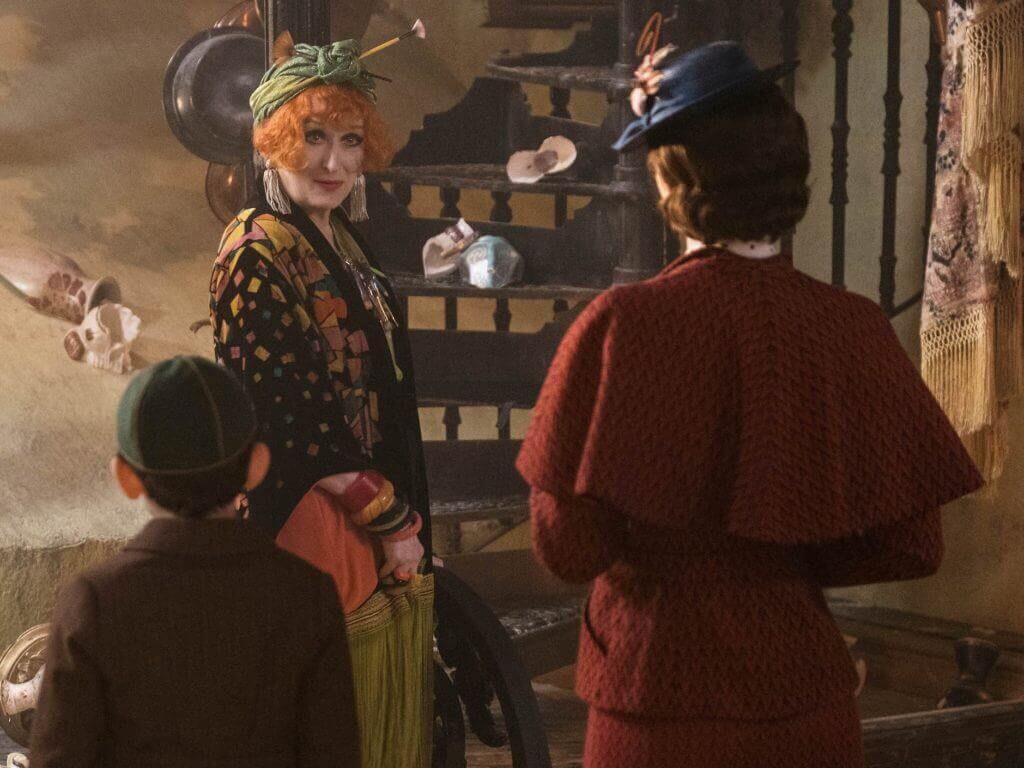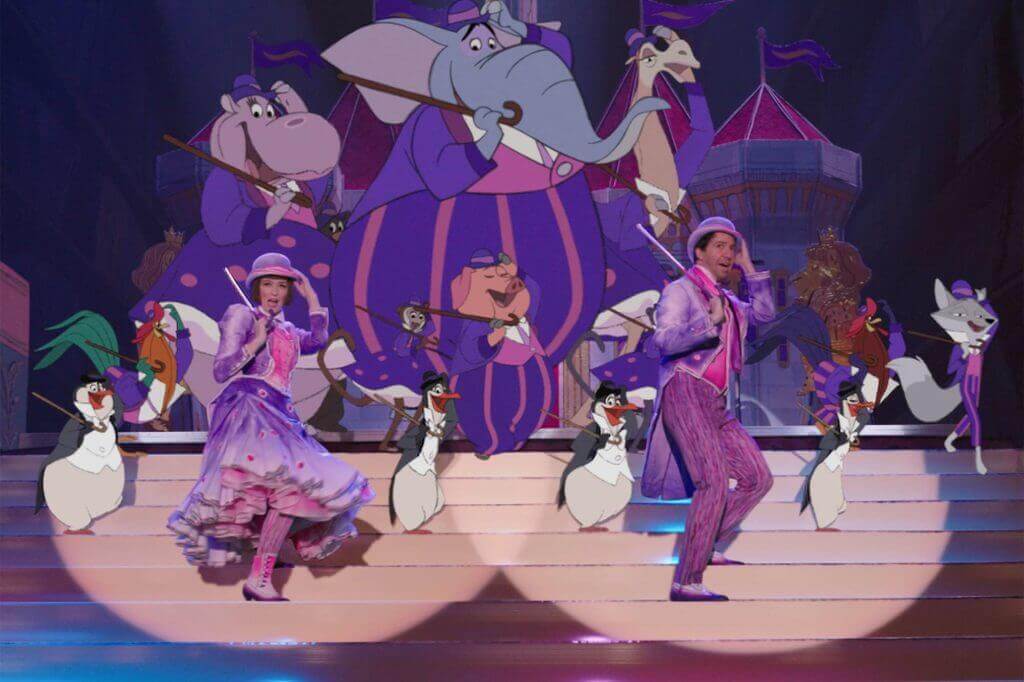REVIEW: Mary Poppins Returns (2018)
When Disney announced that Mary Poppins Returns, a sequel to 1964’s Mary Poppins, was in the works, I was intrigued but incredibly nervous. I find myself saying that more and more about Disney projects, especially sequels, reboots, or pretty much continuations of any kind. I say all the time that Disney is my favorite thing, and in fact, their movies got me interested in film in the first place. That being said, they tend to have quite a mixed-bag output, like most other studios. But when a studio has been so successful for so long, it grows tiresome watching them continually miss the mark. And the truth is, Mary Poppins, while admittedly based on a series of books, was never prime sequel material. The first film is satisfying and self-contained, with no loose ends; but more than that, it’s perfect. I’m reluctant to call any movie perfect, and it’s hard to get me to call one great; even some of my most favorite films have flaws, and I wouldn’t call them perfect. However, the first Mary Poppins film really is “practically perfect in every way.”
The cast of Mary Poppins is phenomenally chosen, and their performances are amazing. In fact, I think the players aside from Julie Andrews and Dick Van Dyke often don’t get the credit they deserve; David Tomlinson delivers a funny, sympathetic, and dynamic performance as the children’s over-worked, distracted father. Meanwhile, Glynis Johns is endearing and absolutely hysterical as Mrs. Banks. Everyone from the children to the family servants to side characters like Uncle Albert and Admiral Boom is perfectly utilized and well acted. Andrews and Van Dyke are, of course perfect, with the former giving one of my favorite performances in any movie, period. The animation is gorgeous, and this is one of the finest examples of mixing the medium with live-action footage, and the Sherman Brothers’ songs and score are sublime and iconic. From the grandest musical number to the simplest costume choice, the first film doesn’t have anything I think they should have changed or left out to improve it. It’s a very complete experience that leaves the viewer full of emotion and, perhaps, with something to consider. I mention this both because Mary Poppins Returns borrows much from its predecessor and this makes how I feel about the original extremely relevant, and because the sheer quality of the original film and its satisfying conclusion make the decision to even attempt a sequel puzzling.

Mary Poppins Returns finds the Banks children approximately 20 years older and with brand new problems. Michael’s wife has passed away, leaving him with three growing children of his own and a mortgage he can’t pay. Jane says that where her love life is concerned, “that ship has sailed,” and throws herself into union work. Meanwhile, Michael’s kids, Georgie, Anabel and John, take on the roles of adults, doing the cleaning and shopping rather than leaving it to their father or their still-living maid Ellen. With the help of lamplighter Jack, Mary Poppins returns to help the Banks family once again.
I’d like to start by saying that I admire Emily Blunt for doing her own thing to an extent, rather than copying Julie Andrews’ iconic turn as the flying nanny. If you can believe it, this iteration of the character is even more prim, proper and vain. She still has a hint of sweetness, but it’s less pronounced than Andrews’ version. Her singing and dancing are on-point, she emotes well, and she’s a delight to watch. I don’t really like this version of Mary, and I find her character inconsistent, but I think it’s worth pointing out that Blunt does a great job and I don’t fault her for my issues. It’s been said that the Mary of Mary Poppins Returns is truer to the books, and if that’s so then good for them, but it’s not for me. I liked the stern but motherly version Julie delivered, and despite Blunt doing a good job, Julie’s singing is something I definitely missed here. Regardless of tweaking the character slightly, they can’t even make this version believable and consistent. There’s a musical number early in the film called “The Cover is Not the Book” that was surely put in just to show off the traditional Disney animation and Lin-Manuel Miranda’s skills at spitting words. That’s all well and good, but I really hated this scene for numerous reasons, not the least of which being Mary’s portrayal. Here, she switches to a stereotypical Cockney accent, much like Bert’s in the first film, to sing a song full of bad grammar, while wearing a bob haircut, shorter skirt, and dancing like a 1920’s flapper. To be clear, it’s well done, and I have no moral objections or anything like that, but this isn’t Mary Poppins. As much as P. L. Travers disliked the first film, I can almost feel her rolling in her grave at this… whatever it is. This number somehow managed to get a standing ovation in my theater, surely for the sheer spectacle of it.
Miranda and Blunt do well at singing and dancing here as they do throughout Mary Poppins Returns, but otherwise, I really didn’t like this scene. Making matters worse is that this song isn’t very good, catchy, or even memorable. All of the songs in the film are like this, hollow replacements for songs in the original. Each occurs in the same relative spot in the story – down to the runtime – as a better, classic song from the original. They tweak little things here to create a veneer of freshness; instead of being put-upon at work and having unrealistic expectations for his family like his father, Michael sings about his dead wife and wonders “where she went.” Rather than using magic and music to clean up the nursery and teach the children to be fastidious, Mary uses it to trick them into a bath. The first problem, again, is that the songs aren’t good. However, it’s a bigger problem for me that they’re trying too hard to emulate the original and pander to fans. Mary Poppins Returns is too concerned with reminding us that the original exists and not enough with its own substandard story and underdeveloped characters. There’s one point where Mary says that some people think too much, and I felt like the filmmakers were talking to me. “Don’t think about it; just sit back and relax!” But how can I not consciously think about the greatness of the first film, and the emptiness of this one, when the connection is constantly at the movie’s forefront?

And it’s not just musical numbers that are guilty of this; emotional scenes, funny scenes, and even characters are all echoes of the original. If you can think of a minor character from Mary Poppins, they’ve got an analog in Mary Poppins Returns. Meryl Streep is the only one who really gets away with this, in my opinion; much like Keira Knightley in Disney’s Nutcracker, I was dreading seeing Streep in this. Both have been vocally political and anti-Disney in the past, and that puts them on my stink list. However, the scene and song featuring Streep was the highlight of the film for me. This was the only song I really liked, and it didn’t remind me too much of its inspiration from the original. It was obvious what inspired it, in fairness, but the staging and performances are done so well that I wasn’t constantly being reminded of it, and the song surprisingly sounds quite different. If the other songs were this good and the other performances this charming, the film might earn enough goodwill to get a pass for all the lazy writing and overtly similar plotlines and characters. And if you’ve seen the commercials and wondered, like me, if Jack was just a repeat of Bert as Mary’s sidekick, he is. He’s exactly the same, with the exception of not having a crush on Mary. The children aren’t distinct like Michael and Jane were in the original film; Georgie acts like a little boy who’s interested in running and playing, the older two children are more mature, and that’s all we learn about them. Ben Whishaw doesn’t give a bad performance as Michael Banks, but his character gets the short end of the stick here. As I mentioned, Mr. Banks is actually one of the best things in Mary Poppins for me. Mary arrives and helps the neglected children, but as they observe in the 2013 film Saving Mr. Banks, it’s really their father who is struggling and confused. Rather than rearranging the world to be right for the family, she changes their dynamic from within by introducing magic and music into the home. In Mary Poppins Returns, everything that worked about this dynamic is stripped away and replaced with what I can only describe as stupidity.
Michael’s character is static in Mary Poppins Returns, as he never really does anything wrong and, thus, doesn’t have to learn anything. Nobody in the family is wrong about anything or makes any mistakes, but rather they’re all suffering the loss of their wife/mother. Michael’s real trouble is external; the bank is trying to repossess the Banks family home, a plot point they make clear in the trailers. Michael arguably did something to lead to this, but one can hardly see anything he could have done differently. This film has a real stereotypical, mustache-twirling villain pulling the strings, and it’s horrible – horribly done, with a cardboard performance, bland writing, and no inspiration to be seen. In Mary Poppins nobody was evil, and nobody was out to get the Bankses, but rather the family members, notably Mr. Banks, made mistakes and grew to learn something. I just don’t see the value in a story of a flawless person being kicked while they’re down for no reason until a magical entity arrives to save them with over-the-top tricks and spells. Especially compared to the more restrained first film, it’s, frankly, stupid. Mary Poppins Returns feels much more childish in this regard. On that note, the magic is way too pronounced in this film. All the lamplighters know Mary is magical, and in the end, the “Let’s Go and Fly a Kite” sequence from the original is taken a step (or ten) too far. In short, they take the concept literally; if you’ve seen the film, you know exactly what I mean. In Mary Poppins, Mary’s manipulations of the situation and of people were covert, and many times the other characters had no idea she had done anything at all. During the climax of Mary Poppins Returns, Mary takes the story into her own hands in a literal, jarring way that seems lazy and far less interesting. I can’t describe this as anything less than disappointing and mindless.

I’d also like to say something about the film’s animated sequences. They’re well done, especially when Mary, Jack and the kids are wearing clothing that looks like watercolors. This is a legitimately cool effect, and it looks amazing. Aside from this, none of the animation is anything special; they mix CGI, live-action and traditional animation in pretty much the way you’d expect. Mary Poppins Returns also does something I really hate: there are characters in the fantasy world that correspond to the real world, a la The Wizard of Oz. It’s obvious from the first frame of the animated characters who is who, the actors are the same, etc. What a cheap ploy to make it seem like the film is saying something. If the animation (again, aside from the watercolor dresses and suits) was more impressive or if these scenes were even entertaining, I might give it a pass. But this is a trope I can’t stand, and Mary Poppins Returns gives me no reason to accept it.
In short, I honestly hated Mary Poppins Returns. This was never going to be as good as the monumental first film that mastered live-action/animation hybrid footage, gave us lovable characters, and memorable and meaningful songs, as well as a healthy serving of character development. It was never even likely that the sequel would be great, let along perfect. I went in with this in mind, trying to temper my expectations so I wouldn’t be disappointed. But the truth is that Mary Poppins Returns constantly reminds you that it’s a sequel to an amazing movie filled with better characters, better songs, and a stronger story. This film isn’t good even on its own merits. The technical aspects are there; the movie looks good, and the actors do their part. But the story and characters are a total repeat. When they do change something, it’s never to the film’s improvement, or even credit. If you have kids or just have no interest in all the other great movies out right now, I guess you should see Mary Poppins Returns. But I wouldn’t recommend it, and I’ll be re-watching the fabulous, inspired, beautiful original to get it off my mind. If anyone was going to love this, it was me, and I feel like I gave the film plenty of chances to win me over. But in the end, it’s just a hollow cash-in on a film that never needed a sequel, or anything that it didn’t already supply.
Mary Poppins Returns
Plot - 5
Acting - 10
Directing/Editing - 2.5
Music/Sound - 1.5
Inspiration - 0
3.8
Awful
The truth is that Mary Poppins Returns constantly reminds you that it’s a sequel to an amazing movie filled with better characters, better songs, and a stronger story. This film isn’t good even on its own merits. The technical aspects are there; the movie looks good, and the actors do their part. But the story and characters are a total repeat. When they do change something, it’s never to the film’s improvement, or even credit. If you have kids or just have no interest in all the other great movies out right now, I guess you should see Mary Poppins Returns. But I wouldn’t recommend it.







